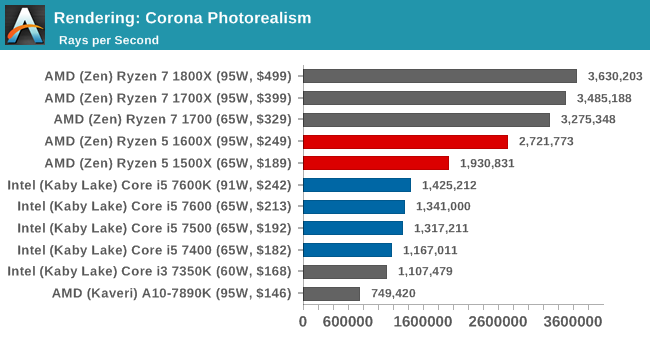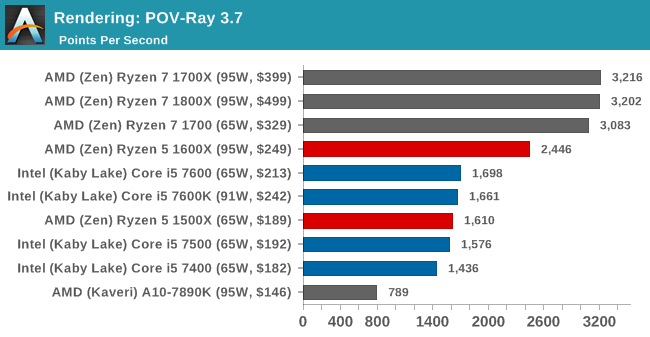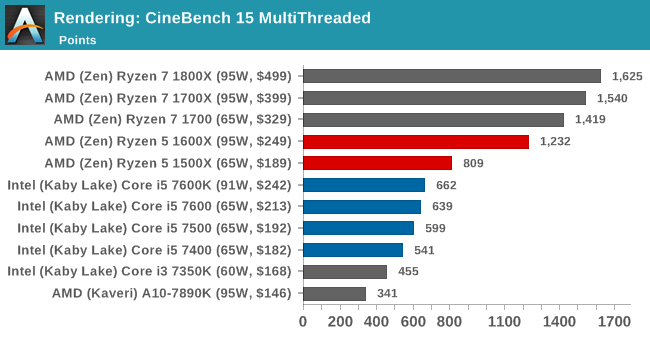The AMD Ryzen 5 1600X vs Core i5 Review: Twelve Threads vs Four at $250
by Ian Cutress on April 11, 2017 9:00 AM ESTBenchmarking Performance: CPU Rendering Tests
Rendering tests are a long-time favorite of reviewers and benchmarkers, as the code used by rendering packages is usually highly optimized to squeeze every little bit of performance out. Sometimes rendering programs end up being heavily memory dependent as well - when you have that many threads flying about with a ton of data, having low latency memory can be key to everything. Here we take a few of the usual rendering packages under Windows 10, as well as a few new interesting benchmarks.
Corona 1.3
Corona is a standalone package designed to assist software like 3ds Max and Maya with photorealism via ray tracing. It's simple - shoot rays, get pixels. OK, it's more complicated than that, but the benchmark renders a fixed scene six times and offers results in terms of time and rays per second. The official benchmark tables list user submitted results in terms of time, however I feel rays per second is a better metric (in general, scores where higher is better seem to be easier to explain anyway). Corona likes to pile on the threads, so the results end up being very staggered based on thread count.
Blender 2.78
For a render that has been around for what seems like ages, Blender is still a highly popular tool. We managed to wrap up a standard workload into the February 5 nightly build of Blender and measure the time it takes to render the first frame of the scene. Being one of the bigger open source tools out there, it means both AMD and Intel work actively to help improve the codebase, for better or for worse on their own/each other's microarchitecture.
POV-Ray 3.7.1
Another regular benchmark in most suites, POV-Ray is another ray-tracer but has been around for many years. It just so happens that during the run up to AMD's Ryzen launch, the code base started to get active again with developers making changes to the code and pushing out updates. Our version and benchmarking started just before that was happening, but given time we will see where the POV-Ray code ends up and adjust in due course.
Cinebench R15
The latest version of CineBench has also become one of those 'used everywhere' benchmarks, particularly as an indicator of single thread performance. High IPC and high frequency gives performance in ST, whereas having good scaling and many cores is where the MT test wins out.















254 Comments
View All Comments
Meteor2 - Wednesday, April 12, 2017 - link
You're quite right. The R7 was a bit 'meh'. It loses a bit too much against the much-higher-clocked i7s. The R5, however, really stands out with better 99th percentile performance and better potential for more to come. (Contary to popular belief, i5s are clocked slower, not faster, than i7s.)Cooe - Monday, March 1, 2021 - link
And yet it was YOU screaming from the roof tops before it came out about just how shit it was going to be... -_-mat9v - Tuesday, April 11, 2017 - link
But then those old games will happily run over 200fps even on Ryzen. Would you care to comment?Can you actually feel the difference in how they work or you are just having a number orgasm?
Reflex - Tuesday, April 11, 2017 - link
Not really sure why I should care about how Ryzen performs in games that are several years old and that even budget CPU/GPU combinations can run more than adequately.cheshirster - Wednesday, April 12, 2017 - link
But Civilisation supports DX12 and it is here in tests with clear win of Zen.MisterJitter - Thursday, April 13, 2017 - link
Now as a precursor I am speculating here, but do you truly believe higher single core frequencies will continue to be the future of CPUs that are already pushing the limits. For example, do you believe Intel's next high end gaming CPU is going to be 6-7GHz? I don't think so... Technology used to increase exponentionally until now. I truly believe that if gaming performance is going to increase at the rate that it has over the past 10 years it's going to be because Devs finally star coding for multiple threads instead of relying on ONE workhorse.FriendlyUser - Tuesday, April 11, 2017 - link
Best CPU ever.eldakka - Thursday, April 13, 2017 - link
IMHO, that crown still belongs to the Celeron 300A. 50% overclockable (450MHz) was standard, and with the right riser card you could enable it for dual-socket systems.In today's terms, it'd be like buying two G4560's (3.5GHz, 2 cores, 4 threads, $63RRP e.a.), overclocking them by 50% on air-cooling (no fancy water) to 5.2GHz, and sticking them in a dual socket motherboard. Giving 4C/8T threads at 5.2GHz for ~$130, compared to an i7-7700K 4C/8T 4.2GHz for ~$340.
jrs77 - Tuesday, April 11, 2017 - link
Singlethreaded the i5 still beats the R5 and the i5 comes with an iGPU which is pretty much mandatory for office PCs and small workstations.Sorry to say, but the AMD R5 is pretty much useless for the majority of users, as the most used software is still singlethreaded (Office, Photoshop, etc).
Let's wait and see what the new AMD APUs will have to offer.
stockolicious - Tuesday, April 11, 2017 - link
"Let's wait and see what the new AMD APUs will have to offer."Its the CPU Ryzen replaces Bulldozer connected to a great iGPU - this is where Intel is going to have a rough time as they don't do top of shelf graphics. When released hard to believe AMD wont have by far the best APU they have made and maybe the best on the market. This might even get them some high end design wins that "Eluded" them during the bulldozer times.